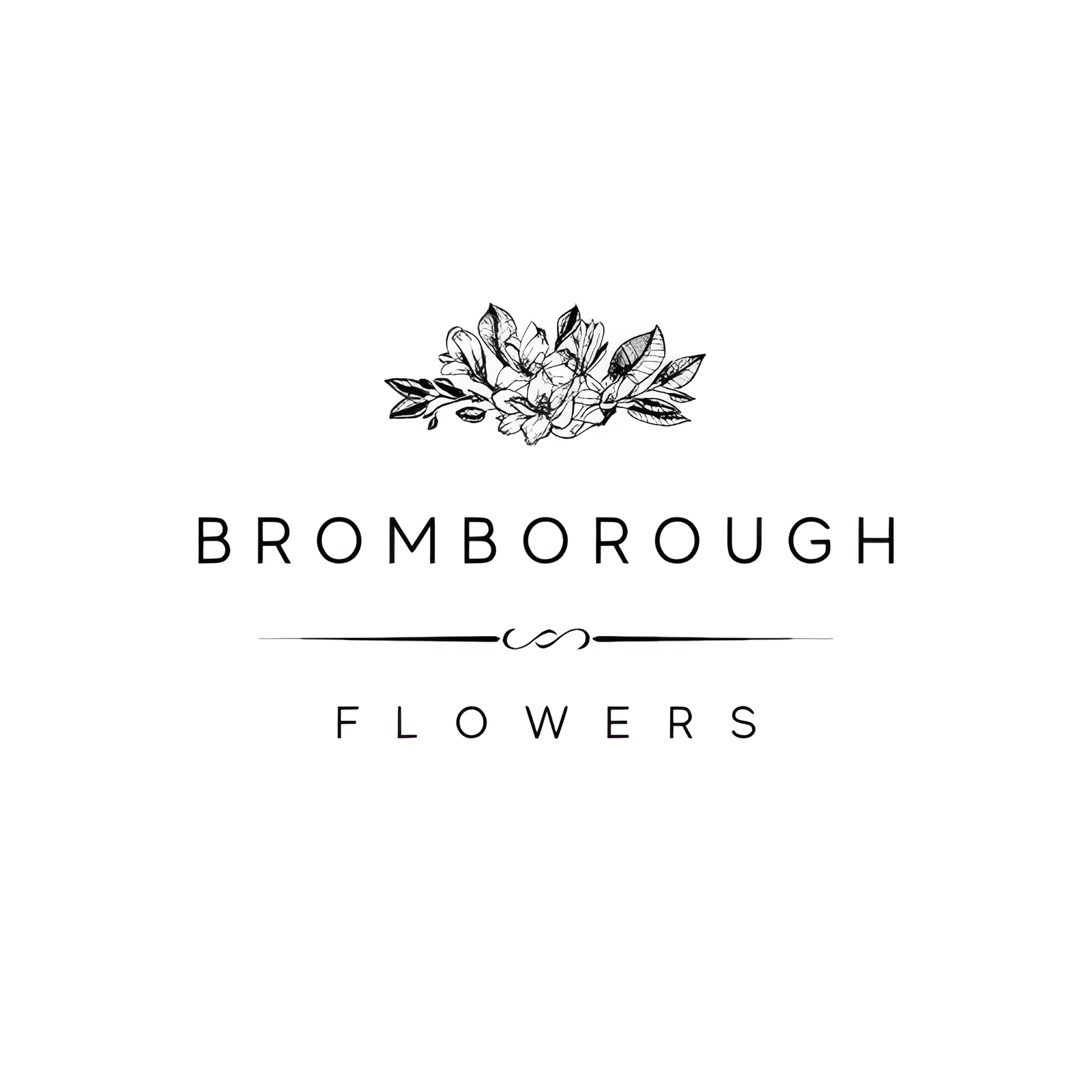The Protea flower, renowned for its striking appearance and robust nature, has garnered considerable attention in wedding floral arrangements, providing a unique and exotic touch to bridal decor. This bloom, with varieties such as the King Protea and Pincushion Protea, offers an array of vibrant colors and a resilient structure, making it a favorite among florists and brides alike. Symbolizing transformation and lasting love, the Protea’s cultural significance enhances its appeal. Intrigued by how this flower can elevate your wedding aesthetic while embodying meaningful symbolism? Discover more about its versatility and charm.
Flower Overview
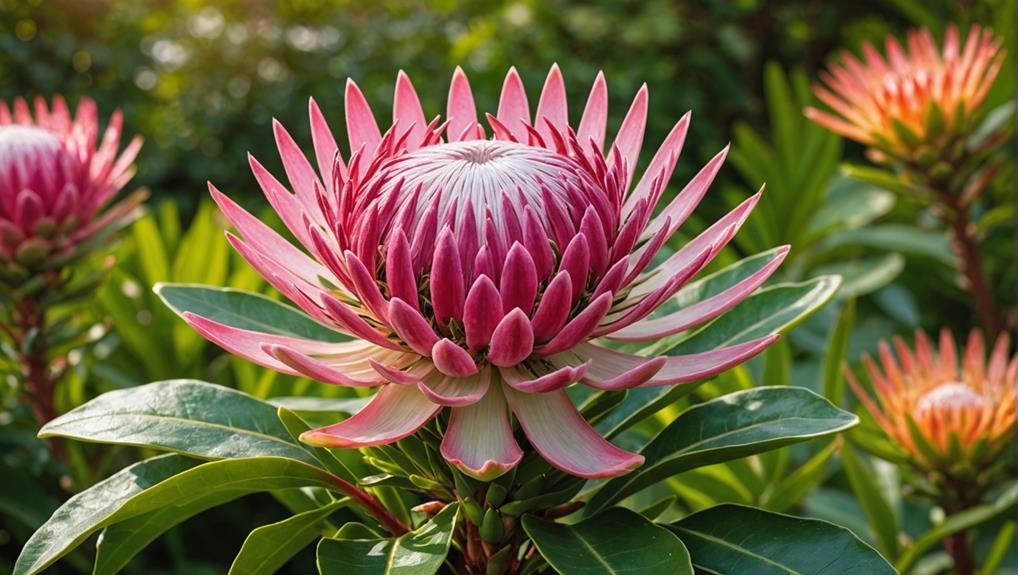
Protea, a genus within the Proteaceae family and indigenous to South Africa, was christened after the Greek deity Proteus by Carl Linnaeus in 1735. Renowned for its remarkable and distinctive look, Protea has become a trendy choice in wedding flower compositions.
These blooms are readily available year-round in wholesale markets, often vended in bundles of 10 or 15 stems, which renders them a practical choice for event organizers and florists.
The adaptability and variety of species of Proteas make them a superb addition to wedding bouquets and other flower arrangements. Their consistent presence all through the year guarantees that couples can integrate these tropical blossoms into their ceremonies, irrespective of the time of year.
The lengths of Proteas’ stems differ based on the species, offering versatility in crafting both large and petite floral exhibitions.
For those mapping out a wedding, incorporating Protea flowers can introduce a distinct and exotic flair to the overall visual appeal. Their unique appearance can complement a range of motifs and color schemes, making them fitting for both classic and modern wedding designs.
Whether employed as the centerpiece in a bouquet or as a component of a more extensive arrangement, Proteas provide a lasting and refined floral choice.
Physical Description
The large, showy blooms of proteas captivate with their unique, intricate shapes and vibrant colors, ranging from pink and red to orange and yellow. These striking flowers are known for their bold and dramatic appearance, making them a standout choice for any floral arrangement. The physical description of protea flowers reveals a range of fascinating features that contribute to their distinctive charm.
- Large King Protea: The King Protea, one of the most recognizable varieties of Protea, boasts a massive bloom that can reach up to 12 inches in diameter. Its central dome of densely packed, tubular florets is surrounded by large, colorful bracts, creating a stunning visual impact.
- Varieties of Protea: Other notable Protea types include the Pink Ice Protea and the Pincushion Protea. The Pink Ice variety features elongated, conical blooms with soft pink hues, while the Pincushion variety is characterized by its spiky, spherical appearance.
- Structural Details: Protea flowers typically have a robust, woody stem and leathery leaves, which add to their durability and longevity. The intricate arrangement of their petals and bracts provides a textured, almost architectural quality that enhances their exotic appeal.
These characteristics make proteas a versatile and eye-catching addition to any wedding floral design.
Available Colour Varieties
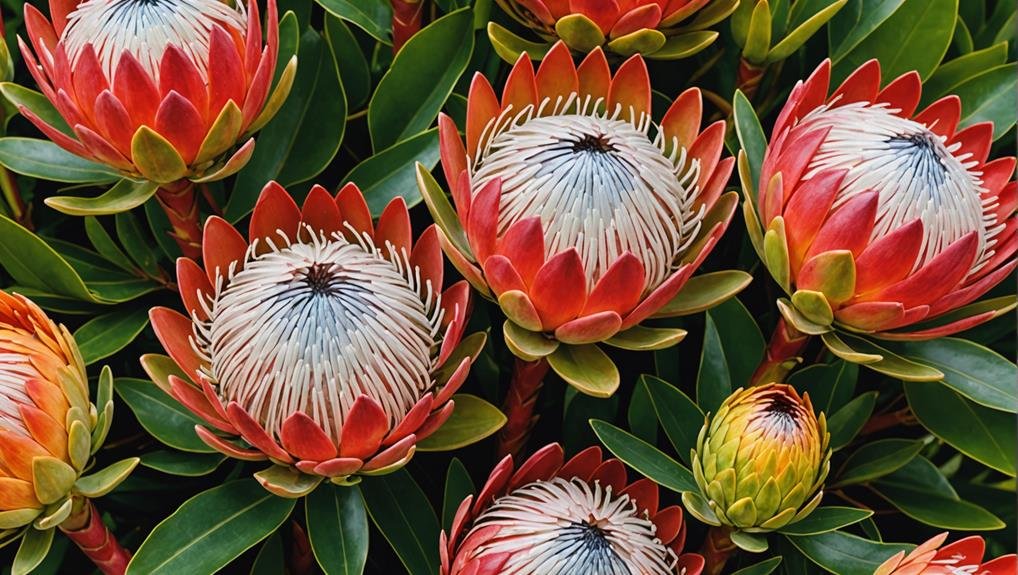
In addition to their unique structural characteristics, proteas captivate with a diverse palette of vibrant colors that can enhance any wedding floral arrangement. These flowers are available in a stunning array of hues, including pink, red, orange, and yellow, offering endless possibilities for creating visually striking bouquets and centerpieces.
Different species of protea bring subtle variations to these colors, ranging from soft pastels to bold tropical shades. For those aiming for a romantic and delicate look, pastel proteas in shades of pink and yellow can provide a gentle touch. Conversely, if the wedding theme calls for something more vibrant and eye-catching, rich reds and bright oranges can add a dynamic flair to the décor.
The versatility in color allows for personalized and unique floral arrangements that can be tailored to complement any wedding color scheme or theme. When selecting proteas, it is crucial to ponder these color options to achieve a cohesive and visually appealing result.
Whether aiming for a soft, elegant ambiance or a lively, tropical atmosphere, the wide range of protea colors ensures that there is a perfect fit for every bridal vision.
Latin Name and Taxonomy
As a member of the Proteaceae family, the Protea genus encompasses a diverse group of flowering plants known for their striking appearance and unique structural characteristics. The Latin name for this genus is Protea, a designation attributed to the Swedish botanist Carl Linnaeus in 1735. Linnaeus named the genus after the Greek god Proteus, who was known for his ability to change shape, reflecting the remarkable diversity within this group of plants.
Proteas are renowned for their:
- Diverse Forms: The genus includes a variety of shapes and sizes, from compact, shrub-like plants to larger, tree-like species.
- Vibrant Colors: The colorful, often dramatic flower heads range from soft pastels to vibrant hues, making them a popular choice in floral arrangements.
- Unique Structure: The flower heads are composed of numerous small, tubular flowers surrounded by colorful bracts, creating a distinctive, architectural look.
The Protea genus plays a significant role in horticulture and floral design, particularly in wedding arrangements where their bold presence adds a memorable touch. Understanding their Latin name and taxonomy not only enriches our appreciation of these plants but also highlights their botanical significance.
Geographical Origins

Native to the diverse landscapes of South Africa, Proteas have adapted to a range of environmental conditions, from coastal plains to mountainous regions. The Protea genus, part of the larger Proteaceae family, showcases an impressive array of species that thrive in these varied habitats.
Named by the renowned botanist Carl Linnaeus in 1735, Proteas draw their name from the Greek god Proteus, known for his ability to change form, a fitting tribute to the flower’s diverse and unique characteristics.
South Africa’s national flower, the King Protea (Protea cynaroides), stands as a symbol of courage, transformation, and diversity. This majestic species, with its large and striking blooms, epitomizes the rich floral heritage of the region. The King Protea is particularly celebrated for its robust presence in both natural and cultivated landscapes, making it a popular choice for wedding arrangements and bouquets.
The adaptability of Proteas to South Africa’s varied climates has contributed to their widespread cultivation and popularity. These flowers are typically available in wholesale markets, sold in wraps of 10 or 15 stems, ideal for creating stunning floral displays. Their unique beauty and symbolic significance make Proteas a cherished choice for wedding celebrations worldwide.
Season Availability
Understanding the seasonal availability of Proteas can help guarantee their best inclusion in wedding arrangements and bouquets. Proteas are primarily in season from spring to early autumn in the Northern Hemisphere, making them an excellent choice for summer and fall weddings.
Their vibrant and unique appearance can add a special touch to any wedding bouquet, creating a striking effect that stands out.
Availability of Proteas can vary based on location and specific types, but generally, they are easier to source during their peak seasons. Wedding florists can assist in securing these blooms for specific dates, ensuring that couples can enjoy their beauty without worry.
The cost of Proteas may also fluctuate depending on their season availability and demand, so it’s advisable to plan ahead and consult with florists early in the planning process.
To help visualize their seasonal charm:
- Spring: Fresh and blooming, ideal for early wedding dates.
- Summer: Abundant and vivid, perfect for capturing the essence of the season.
- Fall: Rich and robust, adding warmth to autumnal celebrations.
Various types, including King, Pink Ice, Pincushion, and Blushing Bride, each have their distinct characteristics and seasonal peaks, allowing for a diverse range of options for any wedding bouquet.
Growing Conditions
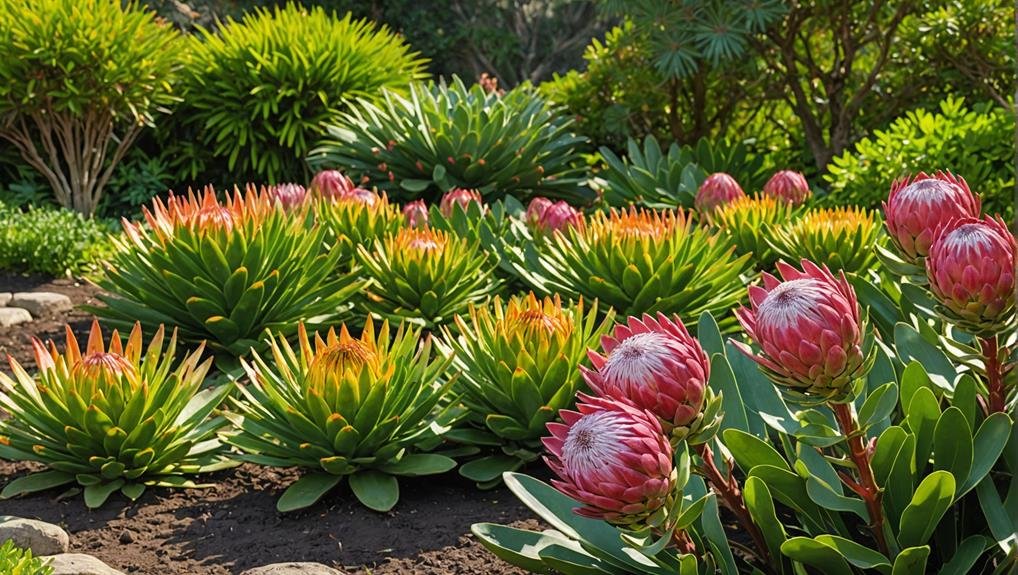
Proteas require well-drained soil with a pH range of 5.5 to 6.5 and full exposure to sunlight for best growth. These growing conditions are essential for ensuring the best health and vibrancy of the protea plant. The soil must effectively drain to prevent waterlogging, which can lead to root rot and other complications. The pH level should be slightly acidic to neutral, as this range supports nutrient availability and uptake by the plant.
Full sunlight is critical for proteas, as it encourages robust growth and flowering. However, while they thrive under the sun, proteas also need protection from strong winds that can cause physical damage to the plant. Additionally, proper air circulation is necessary to prevent fungal diseases, a common threat in dense, poorly ventilated areas.
Proteas are drought-tolerant and perform well in moderate temperatures. They are sensitive to frost, necessitating protective measures in colder climates.
Cultural Significance
Renowned for their striking appearance and symbolic meanings, proteas hold deep cultural significance in South Africa, where they are celebrated as the national flower. This remarkable bloom is not only a reflection of the region’s rich biodiversity but also a powerful emblem of the nation’s values and heritage.
In South African culture, the Protea flower symbolizes courage, diversity, and transformation, resonating with the country’s complex history and resilient spirit.
To paint a vivid picture of the cultural significance of Proteas, consider the following:
- Symbol of Strength: The Protea is admired for its ability to flourish in challenging environments, making it a symbol for resilience and endurance.
- Diversity and Transformation: Reflecting South Africa’s diverse populace, the Protea encompasses a variety of shapes and colors, symbolizing unity in diversity and the nation’s transformative journey.
- Ceremonial Use: Frequently integrated in traditional ceremonies and celebrations, the Protea serves as a link between past traditions and contemporary practices.
Typical Use in Weddings
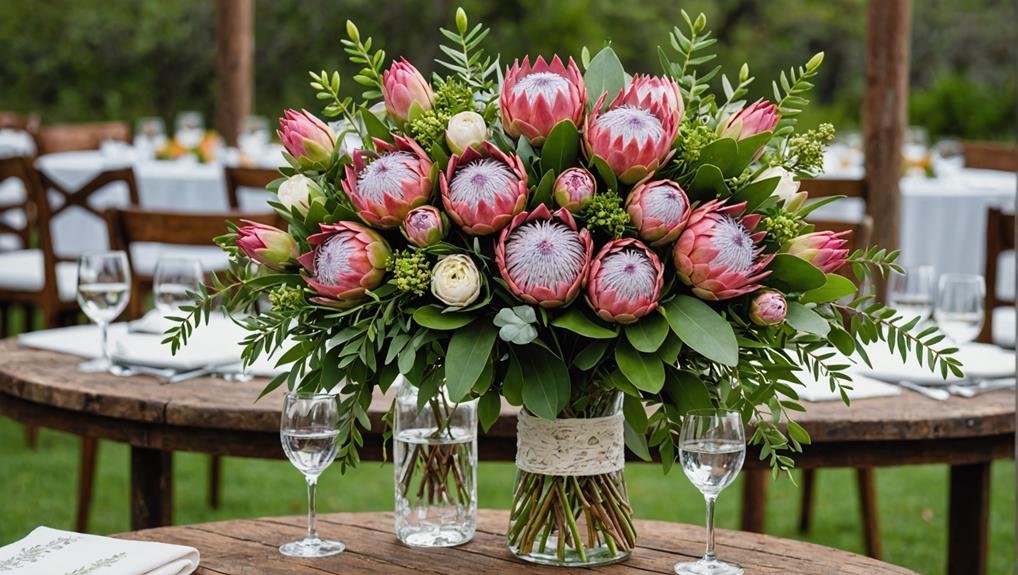
Incorporating proteas into wedding decor imparts an exotic and unique flair, making them highly sought-after for bridal bouquets, centerpieces, and floral arrangements. The striking, large blooms of proteas offer a bold statement that enhances various wedding styles, whether rustic, tropical, or modern. Their versatility allows them to seamlessly blend into any setting, providing a touch of elegance and sophistication.
Protea arrangements are particularly popular in bridal bouquets, where they symbolize courage, transformation, and lasting love—qualities that resonate deeply with the essence of marriage. Their availability in different colors and species adds to their appeal, enabling customization to match specific wedding themes and color palettes.
Centerpieces featuring proteas can transform reception tables, bringing a sense of grandeur and vibrancy. In outdoor weddings, these flowers complement the natural surroundings, enhancing the overall aesthetic with their unique texture and form. Proteas also work well in combination with other floral elements, creating a cohesive and harmonious look.
Alternative Flower Types
When considering alternative flower types to complement or diversify your wedding arrangements, several unique and striking options are available beyond the traditional protea. For instance, the blushing bride protea, with its delicate pink hues and soft texture, offers a romantic touch to any bouquet.
The pink ice protea, known for its vibrant color and robust structure, can add a bold statement to your floral designs. The pincushion protea, with its intricate and eye-catching form, provides a modern twist to classic arrangements.
For those looking to explore beyond protea species, several other floral options can be incorporated for added variety and interest. Consider the following:
- Leucadendron: These striking foliage plants come in various colors and can add depth and contrast to your arrangements.
- Banksia: Known for their unique shapes and textures, banksias bring an exotic flair to your floral designs.
- Native Australian Flowers: Options like kangaroo paw or grevillea can offer a distinctive and natural aesthetic.
Mixing these alternatives with exotic blooms such as anthuriums or heliconias can also create a stunning, tropical-inspired floral design, ensuring your wedding arrangements are both memorable and unique.
